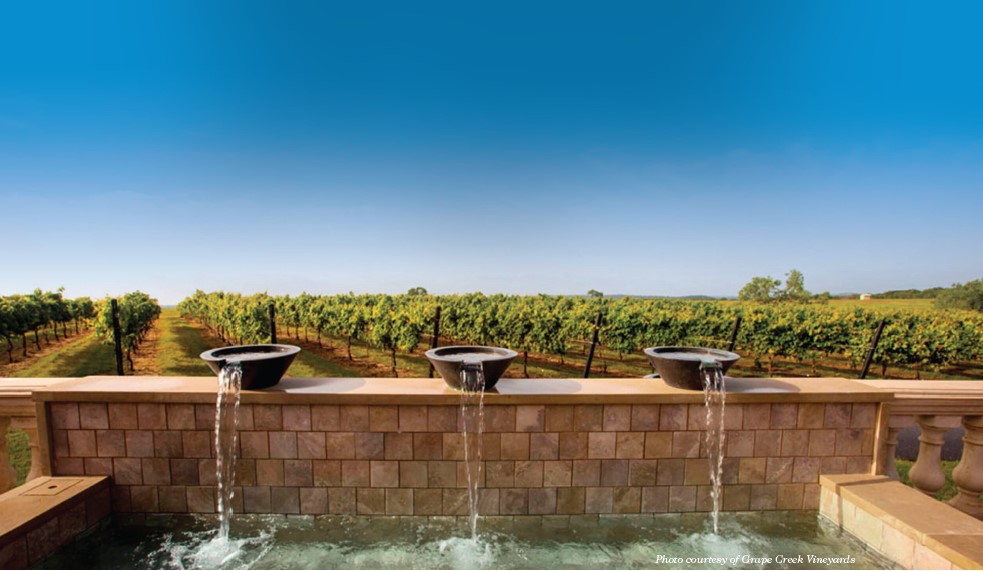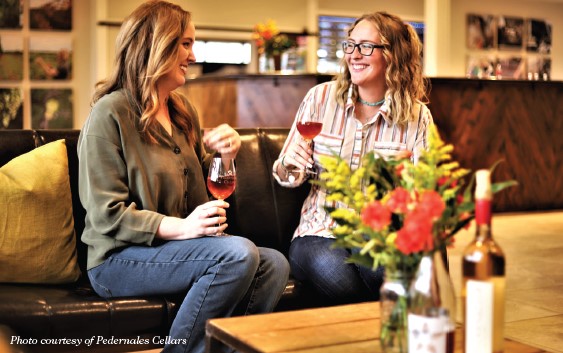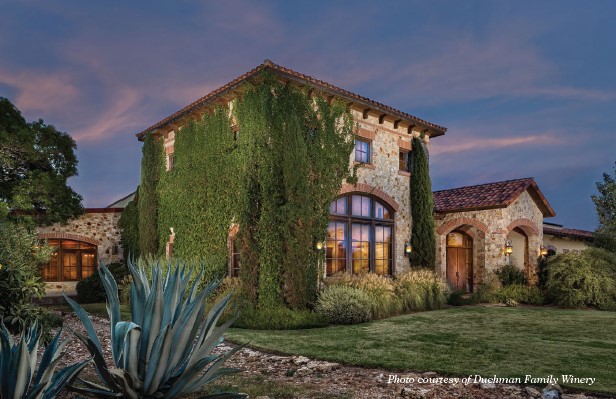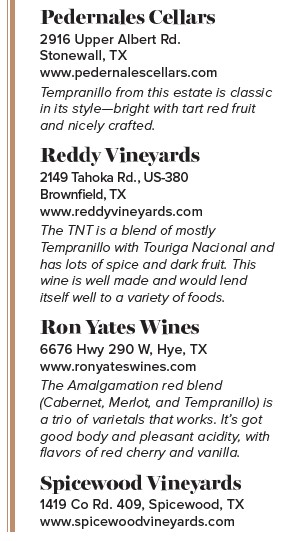If everything is bigger in Texas, then the Texas wine industry is no exception. From the vast number of grape varieties grown, to the eight AVAs that cover an expansive portion of land, to the gallant personalities of the grape growers and winemakers across the state, Texas wine is vast and here to stay.
A Quick History
The Texas wine industry is not exactly new, though not exactly old. The state holds claim to the site of the first North American vineyard planted by Franciscan priests around 1662. Like other states, European settlers brought grapes with them and planted vineyards through the 1800s. But Prohibition ended grape production in Texas, and it wasn’t until the 1970s—much like other “newcomer” winegrowing states—that grape growing came back on the Texas radar.
Farming: Grapes and Otherwise
 “Our cousins Ed and Susan Auler, one of the first families of Texas wine, planted Fall Creek Vineyards back in the 1970s on the family ranch,” said Ron Yates, president and owner of Ron Yates Wines and Spicewood Vineyards. “We are about as connected to the history of Texas wine growing as you can be.” The Yates family has been ranching and farming in Texas for eight generations, and like them, many grape growers across the state have a longstanding history of working with Texas land.
“Our cousins Ed and Susan Auler, one of the first families of Texas wine, planted Fall Creek Vineyards back in the 1970s on the family ranch,” said Ron Yates, president and owner of Ron Yates Wines and Spicewood Vineyards. “We are about as connected to the history of Texas wine growing as you can be.” The Yates family has been ranching and farming in Texas for eight generations, and like them, many grape growers across the state have a longstanding history of working with Texas land.
As an agricultural state, Texas is no stranger to varied growing conditions, the labor of harvest, and the sale of crops. “A lot of our growers are also farming other products like soy, cotton, and lots of different row crops,” stated Roxanne Meyers, President of the Texas Wine and Grape Growers Association. “And some of those people are our better growers because they look at it with a scientific approach,” she furthered.
At the forefront of Texas grape growing, farmers are coupling terroir with grape variety and planting in experimentation to determine which grape varieties thrive. And the ability to understand and combat the extreme weather challenges is paramount to success. “Texas is an extreme weather state. We have to deal with late freezes, hailstorms, and drought conditions on a regular basis,” said Jim Evans, owner and winemaker of Lost Oak Winery. But for many of the generational Texas farmers, their longstanding commitment to farming the land has given them the upper hand when it comes to growing grapes under such conditions.
Texas Terroir
Terroir is another factor that generational farmers understand. Across the state, there is a wide range of appellation sizes. Some are very small, such as Texoma and the Davis Mountains. “Texoma, on the borderline of Oklahoma, has lots of hills. We are seeing really good fruit come out of that area because it gets more arid and hillier as you go into Oklahoma,” Meyers admitted. However, one of the logistical challenges of these smaller appellations is their remoteness, which makes it challenging to truck grapes to winemaking facilities in more populated parts of the state.
Two of the larger and more recognizable AVAs in Texas are Hill Country and High Plains, and these two appellations are garnering the most attention for their terroir and nicely crafted wines. In Hill Country, an area whose vineyards and reputation are quickly growing, the land is comprised of granitic soils. In the High Plains, which has the most vines in the ground by far, the soils are primarily sandy loam and limestone. These regions are proving viable for several grape varieties such Grenache, Syrah, Mourvèdre, Montepulciano, and Aglianico. But Tempranillo has been the most consistent and is quickly showing itself as one of Texas’s brightest and most promising varietals.
When it comes to white wines, more obscure varieties like Picpoul Blanc and Albariño fit the bill—and like the reds, prove that Texas grape growers are not afraid to veer away from more well-known varietals like Chardonnay and Sauvignon Blanc just for the sake of recognition. “Early enthusiasm for the grapes that established California as a world-class growing region has been largely replaced by the realization that Texas is very unlike California, and hence should develop its own oenological voice, and is doing so,” said Julie Kuhlken, co-founder and chief marketing and hospitality officer of Pedernales Cellars. Texas grape growers are seeking the best varietals for their terroir, which truly speaks to Texas’s burgeoning temperament as a viable winegrowing region.
Growth and Development
The Texas wine industry has looked to out-of-state consultants to help with some of the logistical challenges of making wine in their great state. Wineries are hiring experienced and educated viticulturists to help them adapt to some of the more significant weather challenges, and consulting winemakers are helping to push the envelope of quality. However, Meyers admits that the state still has progress to make. “I think it is a critical time to focus on those varieties that are doing well and capitalize on those,” she said. “I have been in the industry now for 15 years, and I have seen a fabulous evolution in quality. It’s night and day from where we were 15 years ago.”
The steady increase in Texas wine quality is garnering attention, and as the state continues to improve its viticulture and winemaking practices, its output and impact will continue to grow. Many grape growers finally feel like they “have the right grapes in the ground,” stated Yates, and that is precisely where Texas winegrowers and winemakers need to be.







